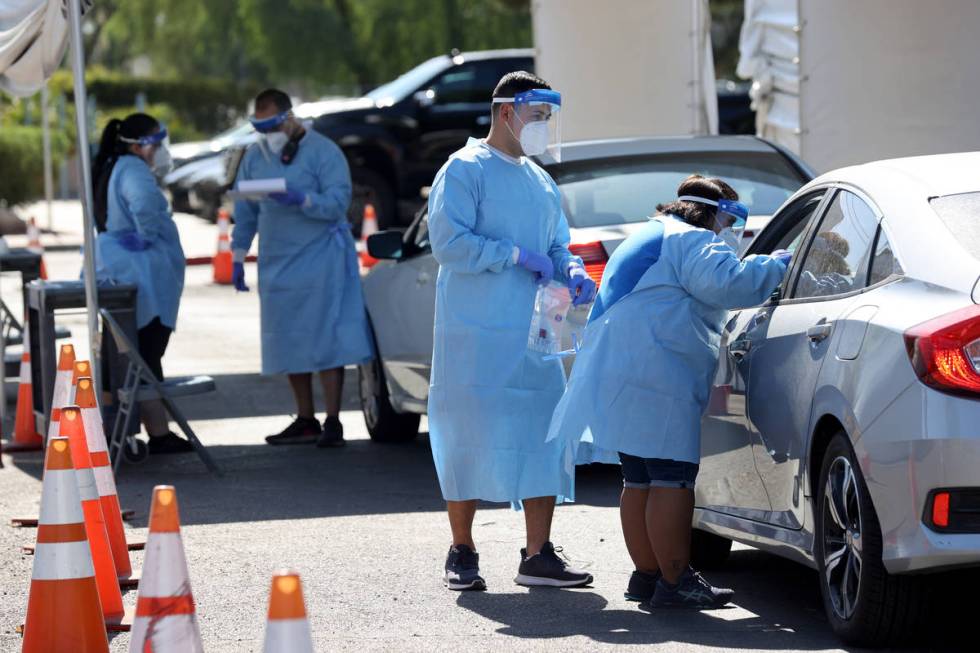Nevada, Clark County report fewest new COVID-19 cases since mid-June

Nevada and Clark County both recorded the lowest single-day increases in new cases of COVID-19 in more than two months, but deaths from the disease remained higher than the average seen in recent weeks, according to data posted Wednesday.
The Department of Health and Human Services reported 253 new cases over the preceding day on its nvhealthresponse.nv.gov website, bumping the state case total to 66,666. Reports from local health districts and counties place it somewhat higher, at 66,679 as of Wednesday evening.
The state also reported 20 additional fatalities from the disease caused by the new coronavirus, bringing the death toll to 1,250.
New cases were well below the daily average of just over 539 for the preceding week, and marked the lowest single-day increase reported since the agency added 234 cases on June 17.
Fatalities were slightly above the daily average of just over 18 for the period. State public health officials have said that deaths typically occur up to five weeks after infection, meaning the higher fatality numbers seen in recent weeks likely stem from a crest of COVID-19 cases in the state from mid-July into early August.
The state’s infection or positivity rate, considered a better indicator of the trend of the outbreak in the state than daily new cases and deaths numbers, remained unchanged at 11.47 — just the fourth time since June 17 that the rate has not risen.
COVID-19 testing, which can affect the infection rate, continued to slow, according to the state data, with 3,407 tests reported. That was well below the daily average of nearly 8,153 for the preceding week. Overall, the number of tests reported has decreased from more than 49,000 in the third week in July to less than 27,000 last week.
State health officials on Wednesday vowed to reverse the trend, saying they would increase testing in both the north and south.
Big testing effort in Clark County
Separately, Clark County officials announced a partnership with the state and the U.S. Department of Health and Human Services would be providing 60,000 additional tests over a two-week period starting Aug. 31 as part of a surge program for virus hot spots. The program has previously supplemented testing capacity in Texas, Louisiana and Florida.
Local officials described the effort as an “incredible, unprecedented boost in testing” and a “blitz attack.” County Commission Chairwoman Marilyn Kirkpatrick said the county and its partners to date have consistently administered 5,000 tests daily and more than 20,000 a week.
But Nevada COVID-19 response director Caleb Cage cautioned against seeing the surge testing program as more than a temporary boost.
“It’s not going to be a long-term solution,” he said.
Hospitalizations of confirmed and suspected COVID-19 patients in the state registered another decline, dipping by 11 to a total of 661.
The Nevada Hospital Association said in an update on its website that the state’s “health care infrastructure continues to appreciate a decline in COVID-19 demand and currently is not being significantly stressed by the virus.”
The trade group also said that the situation is improving at Clark County hospitals, some of which were said to be at or near capacity as recently as last week.
Interactive: Tracking the coronavirus’ impact on Nevada through data
“Relative demand of COVID-19 on the Clark County health-care infrastructure continues to decline,” it said, adding that the current total of confirmed and suspected hospitalized cases in the county of 684 was more than 100 lower than the 796 cases reported on Aug. 18.
County case numbers also down
The Southern Nevada Health District, meanwhile, reported 152 new cases of COVID-19 and 20 deaths in Clark County over the preceding day.
Data posted on the district’s coronavirus web page showed the lowest single-day increase since the district reported 80 new cases on June 14, bringing the case total for the county to 57,283. Fatalities reported Wednesday pushed the county death toll to 1,078.
New cases were well below the daily average of nearly 477 for the preceding week, while fatalities were slightly above the daily average of slightly more than 17 for the period.
Both the health district and the state redistribute the cases and deaths after they are reported in an effort to better reflect when people got sick or died, so detailed breakdowns they produce generally don’t match the totals posted in their daily updates.
This is a developing story. Check back for updates.
Contact Mike Brunker at mbrunker@reviewjournal.com or 702-383-4656. Follow @mike_brunker on Twitter. Review-Journal staff writer Shea Johnson contributed to this report.